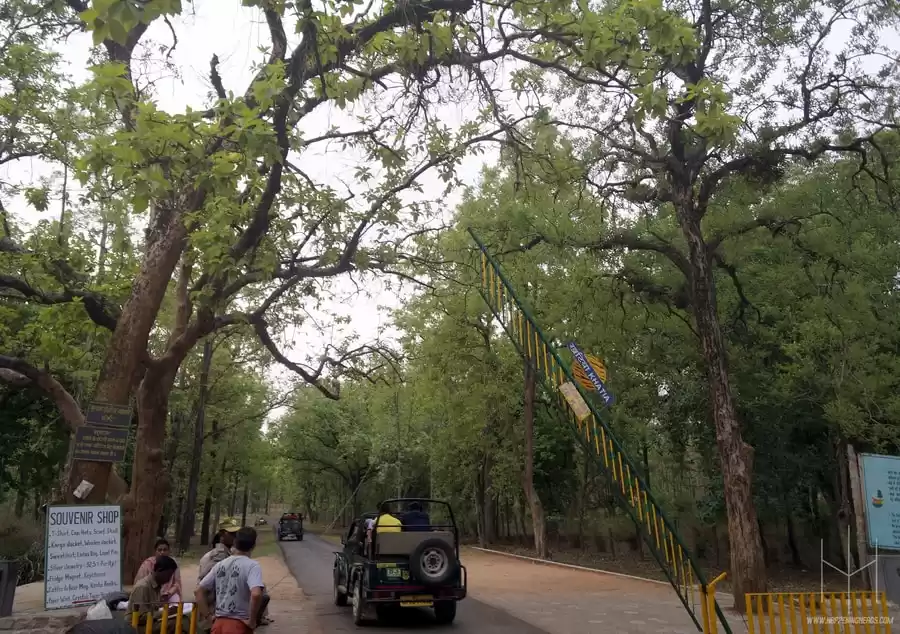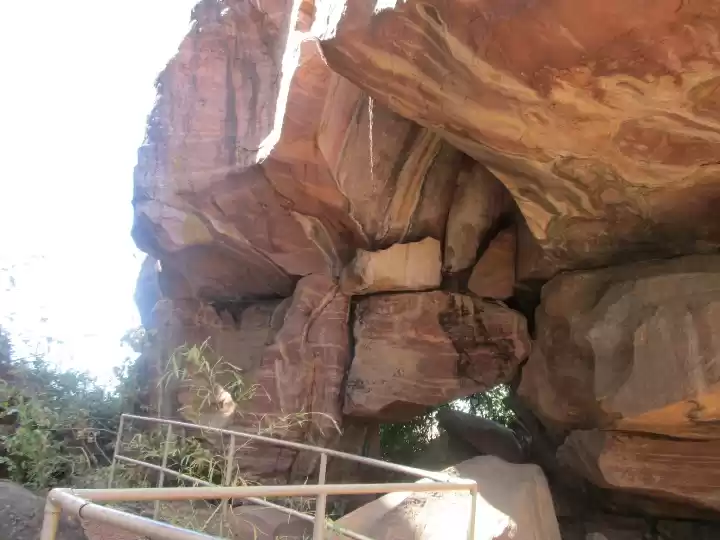The Bhimbetka Rock Shelters are a group of more than 700 caves and rock formations that contain ancient paintings and archaeological evidence of human habitation. They are located in the Raisen district of Madhya Pradesh, India, about 45 km south of the capital city, Bhopal. They are a UNESCO World Heritage Site and a must-see attraction for anyone interested in history, culture, and art.
In this article, we will tell you everything you need to know about the Bhimbetka Rock Shelters, such as their history, legend, culture, and cave paintings, as well as the best time to visit, how to reach, and what to see and do near the site. Read on to find out why Bhimbetka is a journey into the prehistoric era.
History of Bhimbetka

The name Bhimbetka comes from the Sanskrit word Bhīmabēṭakā, which means “the sitting place of Bhima”. Bhima was one of the five Pandava brothers, the heroes of the Hindu epic Mahabharata, who are said to have stayed here during their exile.
The site has been inhabited by various tribes and communities since the Paleolithic era, more than 100,000 years ago. The rock shelters have witnessed the changes and developments in human society, from the Stone Age to the Iron Age, from the medieval period to the modern times.
The archaeological and geological importance of Bhimbetka was first recognized by Dr. V. S. Wakankar, an Indian archaeologist, who discovered the site in 1957. In 2003, Bhimbetka was declared as a UNESCO World Heritage Site, as it represents “the earliest traces of human life on the Indian subcontinent, and shows the beginning of the South Asian Stone Age”.
Cave Paintings of Bhimbetka
The main attraction of Bhimbetka is the cave paintings, which are the oldest and most varied forms of rock art in the world. There are more than 15,000 paintings, spread over 243 rock shelters, that depict the life and culture of the people who lived here over the ages.
The cave paintings can be classified into different periods and phases, based on their age, technique, and content. The oldest paintings belong to the Paleolithic period, dating back to more than 30,000 years ago. They are mostly monochrome, red or green, and show simple geometric shapes, dots, and lines. They are believed to be symbolic or ritualistic in nature, and may represent the early forms of communication or writing.
The next phase of paintings belongs to the Mesolithic period, dating back to 10,000 to 5,000 years ago. They are more colorful, using red, white, green, yellow, and black, and show more complex and realistic images of animals, humans, hunting, dancing, and scenes from daily life. They also show the use of tools, weapons, and domestication of animals, indicating the transition from nomadic to settled life.
The third phase of paintings belongs to the Chalcolithic period, dating back to 5,000 to 3,000 years ago. They are similar to the Mesolithic paintings, but also show the influence of agriculture, trade, and metal work. They also show the interaction and exchange of ideas and culture between the local tribes and the outsiders, such as the Harappans, the Aryans, and the Greeks.
The last phase of paintings belongs to the medieval and modern periods, dating back to 1,500 to 200 years ago. They are mostly white, and show the impact of religion, politics, and warfare on the society. They also show the changes in the style and motifs of the paintings, such as the use of floral and geometric patterns, and the depiction of horses, elephants, and soldiers.
Some of the most famous and impressive cave paintings are found in the following rock shelters:
1. Auditorium Rock Shelter:
This is the largest and most spectacular rock shelter, measuring about 40 meters in length and 15 meters in height. It has a huge auditorium-like hall, with a high ceiling and a circular opening. It has paintings from all the periods and phases, showing a variety of animals, humans, and scenes. It also has some rare paintings of mythical creatures, such as a unicorn, a dragon, and a mermaid.
2. Boar Rock:
This is a rock shelter that has a painting of a giant boar, measuring about 4 meters in length and 2 meters in height. The boar is shown in a dynamic pose, with its mouth open and its tusks visible. It is surrounded by other animals, such as deer, antelope, and birds. The painting is dated to the Mesolithic period, and is considered to be one of the finest examples of rock art in India.
3. Zoo Rock:
This is a rock shelter that has a painting of a zoo, showing a variety of animals, such as elephants, rhinos, tigers, lions, monkeys, and crocodiles. The animals are shown in different poses and expressions, such as playful, angry, or scared. The painting is dated to the Mesolithic period, and is considered to be one of the earliest representations of a zoo in the world.
4. Turtle Rock:
This is a rock shelter that has a painting of a turtle, measuring about 2 meters in length and 1 meter in width. The turtle is shown in a realistic and detailed manner, with its shell, head, legs, and tail visible. It is surrounded by other animals, such as fish, crabs, and snakes. The painting is dated to the Chalcolithic period, and is considered to be one of the rarest paintings of a turtle in the world.
Culture and Legend of Bhimbetka
The Bhimbetka Rock Shelters are not only a historical and artistic treasure, but also a cultural and religious one. They are connected to the local tribes, such as the Gond, the Korku, the Baiga, and the Bhil, who have lived here for generations and have preserved their traditions and customs. They also have a strong link to the Hindu mythology, especially the Mahabharata, which is the source of many legends and stories associated with Bhimbetka.
There are other legends and myths related to Bhimbetka, such as the story of Rama and Sita, the story of the seven sages, and the story of the snake king.
Best Time to Visit Bhimbetka
The best time to visit Bhimbetka is from October to March, when the weather is pleasant and cool, and the vegetation is green and lush. This is also the time when most of the festivals are celebrated, and you can witness the vibrant and colorful culture of the tribes. The average temperature during this period ranges from 15°C to 30°C, and the rainfall is minimal.
How to Reach Bhimbetka
Bhimbetka is well-connected by road, rail, and air, and you can choose the mode of transportation and route that suits you best. Here are some of the options to reach Bhimbetka:
By Air: The nearest airport to Bhimbetka is the Raja Bhoj International Airport in Bhopal, which is about 60 km away. The airport has flights from major cities in India, such as Delhi, Mumbai, Bangalore, and Hyderabad.
By Train: The nearest railway station to Bhimbetka is the Obaidullahganj Railway Station, which is about 3 km away. The station has trains from Bhopal, as well as other nearby cities, such as Indore, Ujjain, and Jabalpur.
By Bus: The nearest bus stand to Bhimbetka is the Obaidullahganj Bus Stand, which is about 3 km away. The bus stand has buses from Bhopal, as well as other nearby cities, such as Indore, Ujjain, and Jabalpur.
By Car: You can also drive your own car or rent a car to reach Bhimbetka. The site is located on the Bhopal-Hoshangabad Road, which is part of the National Highway 69.
What to See and Do Near Bhimbetka
Bhimbetka is not the only attraction in the region, as there are many other places to see and do near the site. You can extend your trip and explore the nearby attractions and activities, such as Bhojpur Temple, Sanchi Stupa, Bhopal Lake and Van Vihar National Park.
Where to Stay and Eat Near Bhimbetka
If you want to stay and eat near Bhimbetka, you have several options to choose from, depending on your budget and preference. Some of the best hotels and restaurants near Bhimbetka are MPT Highway Treat, Tesu, Hotel Palash Residency and Highway Treat Bhimbetka.
Bhimbetka Rock Shelters are a unique and fascinating destination, that offer a glimpse into the prehistoric era and the rich and diverse culture of India. They are a must-visit for anyone who loves history, art, and nature, and who wants to experience something different and memorable.
So, what are you waiting for? Plan your trip to Bhimbetka and discover the ancient and living heritage of India.














































